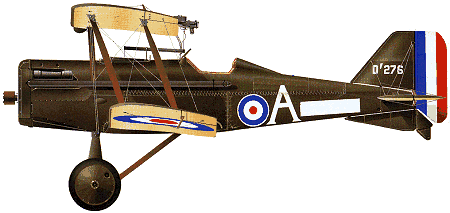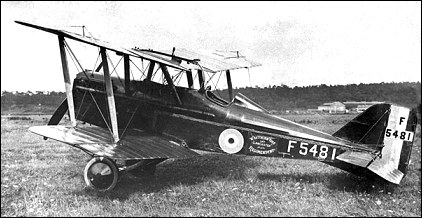|
| The third prototype of the S.E.5 flew at Farnborough on
12 January 1917 powered by a 200hp geared Hispano-
Suiza 8B water-cooled eight-cylinder V-type engine,
but otherwise similar to the 150hp-engined earlier prototypes.
While production deliveries of the 200hp
engine were awaited, airframe modifications were introduced
in the light of early experience with the first
production batch of S.E.5s. In particular, the wing rear
spars were shortened at the tips to provide greater strength, this serving to blunt the previously raked tips
and reduce overall span by 39.4cm. At the
same time, lateral control was improved by shortening
the levers on the ailerons. With a small Avro-type windscreen
in place of the S.E.5's voluminous structure, a
small fabric-covered head fairing behind the cockpit,
the blunt wings and the standard Vickers + Lewis gun
armament, the version with 200hp engine became the
subject of large-scale production as the S.E.5a, starting
with part of the second batch S.E.5s already ordered
from the RAF. Two hundred more were built at Farnborough
itself and, in addition, by the time the war came
to an end in November 1918, some 5125 S.E.5a's had
been built by five companies in less than 18 months:
Austin (1,550), Bleriot & Spad (560), Martinsyde (400),
Vickers (2,215) and Wolseley (400). Production of the
200hp Hispano (in several sub-variants, and including
licence-production by Wolseley as the W.4B Adder I, II
and III) failed to keep pace with this prodigious output,
and numerous operational difficulties with the engine
enhanced the problem. Consequently, many S.E.5a's
were fitted (without change of designation) with the
200hp direct-drive Wolseley W.4A Viper, a derivative
of the French engine. At least six S.E.5a's were flown
with the 200hp Sunbeam Arab I (geared) or Arab II
(direct drive) water-cooled eight-cylinder engine in
trials at Farnborough, and some production aircraft received
high-compression versions of the French-built
Hispano-Suiza engine, increasing maximum" output to
220hp. Twenty-two squadrons of the RFC and the US Air Service were flying the S.E.5a by the time of the
Armistice, but this brought an end to planned largescale
production by Curtiss in the US when only one of
1,000 on order had been completed (in addition to 56
assembled from British components). Service use continued on a small scale for only a short time after the
end of the war, in Australia, Canada and South Africa as
well as with the RAF.

| ENGINE | 1 x Hispano-Suiza engine, 200 hp |
| WEIGHTS |
| Take-off weight | 929 kg | 2048 lb |
| Empty weight | 694 kg | 1530 lb |
| DIMENSIONS |
| Wingspan | 8.11 m | 27 ft 7 in |
| Length | 6.37 m | 21 ft 11 in |
| Height | 2.89 m | 10 ft 6 in |
| Wing area | 22.83 m2 | 245.74 sq ft |
| PERFORMANCE |
| Max. speed | 203 km/h | 126 mph |
| Ceiling | 5180 m | 17000 ft |
 | A three-view drawing (1278 x 942) |
| Anonymous, 23.12.2021 17:03 The S.E.5 was the Royal Aircraft Factory's only real single-seat fighter and by far their best creation. It was designed by Henry Folland, who later created many successful designs for Closter Aircraft and then founded his own company, Folland Aircraft, which created the Gnat light jet fighter and jet trainer. The Royal Aircraft Factory did not go out of business after WW-I, it simply transformed into an experimental and testing agency, somewhat similar to the role played by NACA (later NASA) in the U.S. The name was changed to "Royal Aircraft Establishment (RAE), both to reflect its' new role and to avoid confusion with the newly-created Royal Air Force (RAF). reply | | Michael Gay, e-mail, 06.05.2020 08:27 Try to get a Lanier RC ARF. The SE5-A and the Fokker D-7 are both great flyers, but have been unavailable for nearly 10 years. I was fortunate to find a Lanier SE5-A at a swap meet 5 years ago. Span about 40", weight 32 oz. I'm using a 1300mAh 3S pack on a 1100 kV motor and the prop is a 10x3.8" APC. A 25A ESC is installed and the airplane flys great with this setup.
Both aircraft are built of balsa /lite ply and have slightly undercambered airfoils.
Pat Tritle designed a great little SE5-A many years ago. His designs are EXTREMELY light! I think the short-kit can be obtained from Brodak. reply | | Brian Brookwell, e-mail, 02.06.2015 00:26 I'm creating an E-10 Math drill-and-practice game and would like to use some of your three view drawings for aircraft as part of the game. reply | | James Barnes, e-mail, 30.08.2011 19:20 When I was Deputy Director Weapons at RAE in the early 1980's the Chief of Experimental Flying, Group Captain Reggie Spiers RAF, flew the only surviving SE5a still kept at Farnborough. It had a Wolseley engine and great care had to be taken with the setting of the radiator vents to keep the engine at the right temperature. In all other respects Spiers regarded it as a nice aircraft to fly. reply | |
| | aiqing, 20.06.2011 10:02 Service use continued on a small scale for only a short time after the end of the war, in Australia, Canada and South Africa as well as with the RAF. reply | | Graham Shanks, e-mail, 16.02.2009 21:18 Thank you for the information and the 3 view drawings, I intend making a scale model of this great little biplane, electric powered and radio controlled about 36 inch (91.5cm) wing span. reply |
|
Do you have any comments?
|
| 
COMPANY
PROFILE
All the World's Rotorcraft
|








